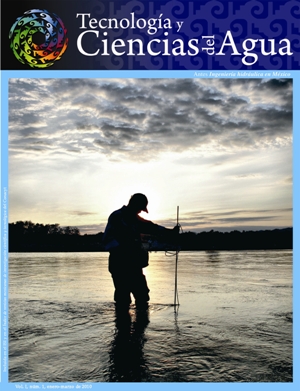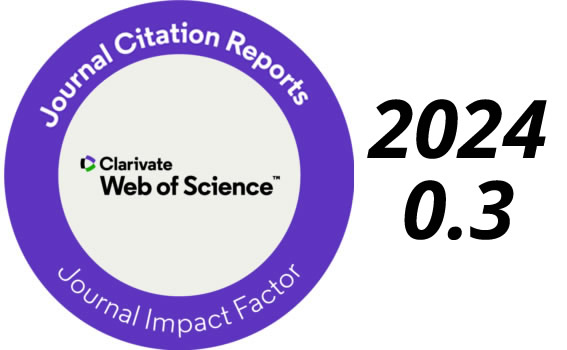Interception loss by mesquite (Prosopis laevigata) and huisache (Acacia farnesiana) in the semiarid region of central Mexico
DOI:
https://doi.org/10.24850/j-tyca-2010-01-08Keywords:
interception losses, evaporation, troughfall, stem flow, water balance, semiarid ecosystems, modellingAbstract
This study was performed in three sites of the semiarid region in central Mexico: “El Carmen” in the State of Guanajuato, and “Amazcala” and “Cadereyta” in the State of Queretaro. The main objective was to assess the interception loss process (EI) of the two dominant species in this region: mesquite (Prosopis laevigata) and huisache (Acacia farnesiana). For each site, two trees were selected, and the experiment was carried out following the methodology proposed by Guevara et al. (2007). Two physically-based models, Rutter et al. (1971) and Gash (1979), and one multiple regression model were used in order to model EI. In 2006, precipitation in El Carmen and Cadereyta was 770 mm and 732 mm respectively, while in Amazcala it reached 451 mm from August to November. The interception loss observed for both species was very similar. The proportion of intercepted rainfall was 15%, 20% and 27 % for huisache and 27%, 22% and 17% for mesquite in Cadereyta, El Carmen and Amazcala respectively. The efficiency coefficient for the EI modelled during the study period for the three models was acceptable, ranging between -1.19<EI<0.94 and 0.62 mm < RMSE< 2.79 mm. At a region level, the EI was of 20%.
References
ALLEN, R.G., PEREIRA, L.S., RAES, D. and SMITH, M. Crop evapotranspiration-Guidelines for computing crop water requirements. Rome: FAO, 1998, 298 pp.
BECERRIL-PIÑA, R., GONZÁLEZ-SOSA, E. and HERNÁNDEZ-SANDOBAL, L. El semiárido mexicano como sumidero de carbono. Estudio de caso Microcuenca “El Carmen”. Memorias del Congreso Nacional y Reunión Mesoamericana de Manejo de Cuencas Hidrográficas. México, D.F. Instituto Nacional de Ecología, 2007, 8 pp.
CARLYLE-MOSES, D.E. Throughfall, stemflow, and canopy interception loss fluxes in a semi-arid Sierra Madre Oriental matorral community. Journal of Arid Environments. Vol. 58, 2004, pp. 180-201.
CROCKFORD, R.H. and RICHARDSON, D.P. Partitioning of rainfall into through fall, stem flow and interception: efect of forest type, ground cover and climate. Hydrol. Process. Vol. 14, 2000, pp. 2903-2920.
GASH, J.H.C. An analytical model of rainfall interception in forests. Quarterly Journal of the Royal Meteorological Society. Vol. 105, 1979, pp. 43-55.
GROEN, M.M. and SAVENIJE, H.H. A monthly interception equation based on the statistical characteristics of daily rainfall. Water Resources. Vol. 42, 2006, pp. 1-10.
GUEVARA-ESCOBAR, A., GONZÁLEZ-SOSA, E., VÉLIZ-CHAVEZ, C., VENTURA-RAMOS, E. and RAMOS-SALINAS, M. Rainfall interception and distribution patterns of gross precipitation around an isolated Ficus benjamina tree in an urban area. Journal of Hydrology. Vol. 333, 2007, pp. 532-541.
HORTON, R.E. Rainfall interception. Monthly Weather Review. Vol. 47, 1919, pp. 603-623.
LEYTON, L., REYNOLDS, R.C. and THOMPSON, F.B. Rainfall interception in forest and moorland. Forest Hydrology. Vol. 163, 1967, 179 pp.
LIU, S. A new model for the prediction of rainfall interception in forest canopies. Ecological Modelling. Vol. 99, 1997, pp. 151-159.
LOESCHER, H.W., POWERS, J.S. and OBERBAUER, S.F. Spatial variation of through fall volume in an old-growth tropical wet forest. Journal of Tropical Ecology. Vol. 18, 2002, pp. 397-407.
MONTEITH, J.L. Evaporation and the environment. Symposium of the Society of Experimental Biology. Vol. 19, 1965, pp. 245-269.
NAVAR, J. and BRYAN, R.B. Fitting the analytical model of rainfall interception of Gash to individual shrubs of semi-arid vegetation in northeastern México. Agricultural and Forest Meteorology. Vol. 68, 1994, pp. 133-143.
NAVAR, J., CARLYLE-MOSES, D.E. and MARTÍNEZ, M.A. Interception loss from the Tamaulipan matorral thorn scrub of north-eastern Mexico: an application of the Gash analytical interception loss model. Journal of Arid Environment. Vol. 41, 1999, pp. 1-10.
RAAT, K.J., DRAAIJERS, G.P.J., SCHAAP, M.G., TIETEMA, A. and VERSTRATEN, J.M. Spatial variability of through all water and chemistry and forest floor water content in a Douglas fir forest stand. Hydrology and Earth System Sciences. Vol. 6, 2002, pp. 363-74.
RODRIGO, A. and ÁVILA, A. Influence of simple size in the estimation of mean through fall in two Mediterranean holm oak forests. Journal of Hydrology. Vol. 243, 2001, pp. 216-227.
RUTTER, A.J., KERSHAW, K.A., ROBINS, P.C. and MORTON, A.J. A predictive model of rainfall interception in forests: derivation of the model from observations in a plantation of Corsican pine. Agricultural Meteorology. Vol. 9, 1971, pp. 367-384.
RUTTER, A.J., MORTON, A.J. Y ROBINS, P.C. A predictive model of interception loss in forest. II. Generalization of the model and comparison with observations in some coniferous and hardwood stands. Journal of Applied Ecology. Vol. 12, 1975, pp. 367-380.
SCHELLEKENS, J., SCATENA, F., BRUIJNZEEL, L. and WICKEL, A. Modeling rainfall interception in lowland rain in forest in Northeastern Puerto Rico. Hydrology. Vol. 225, 1999, pp. 168-184.
VAN-DIJIK, A.I.J.M. and BRUIJNZEEL, L.A. Modeling rainfall interception by vegetation of variable density using an adapted analytical model. Part 1. Model description. Journal of Hidrology. Vol. 247, 2001, pp. 230-238.
XIAO, Q.F., MCPHERSON, E.G., USTIN, S.L. and GRISMER, M.E. A new approach to modeling tree rainfall interception. Journal of Geophysical Research-Atmospheres. Vol. 105, 2000, pp. 29173-29118.
ZENG, N., SHUTTLEWORTH, J.W. and GASH, J.H.C. Influence of temporal variability of rainfall on interception loss. Part I. Point analysis. Journal of Hydrology. Vol. 228, 2000, pp. 228-241.
Downloads
Published
How to Cite
Issue
Section
License
Copyright (c) 2010 Tecnología y ciencias del agua

This work is licensed under a Creative Commons Attribution-NonCommercial-ShareAlike 4.0 International License.
By Instituto Mexicano de Tecnología del Agua is distributed under a Creative Commons Attribution-NonCommercial-ShareAlike 4.0 International License. Based on a work at https://www.revistatyca.org.mx/. Permissions beyond what is covered by this license can be found in Editorial Policy.









